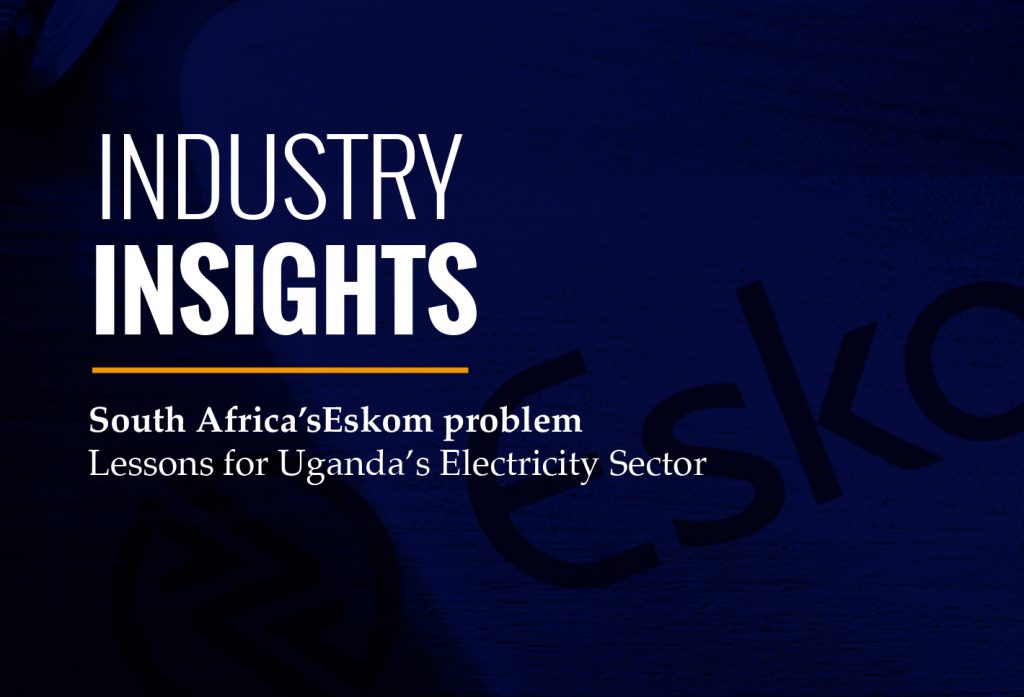Eskom is South Africa’s national electricity utility company that operates as a vertically integrated utility. This means that, unlike the setup in Uganda, it owns the generation, Transmission, and Distribution Assets. It is a replica of what the Uganda Electricity Board (UEB) used to be before the electricity subsector was unbundled in Uganda.
The total capacity of all the Eskom power plants is 48,000MW, which is over 24 times Uganda’s installed generation capacity. This, in effect, means that Eskom’s generation assets can power the entire East Africa region six times over. Eskom also owns and operates 33,000 km of transmission lines and hundreds of thousands of kilometers of distribution lines. This explains why Eskom is the biggest electricity utility in Africa.
Notwithstanding its size, Eskom is struggling with delivering power to its customers. Over the past ten years, South Africa has suffered rolling blackouts arising from load shedding by Eskom. The Eskom debt portfolio currently stands at 22 billion dollars. Its infrastructure is in a state of disrepair, with only 60% of its installed capacity available for dispatch to customers. Between 2013 and 2022, the South African Government spent 9.6 billion dollars bailing out Eskom. It has become too big to fail and is now regarded as South Africa’s most significant economic risk factor.
This therefore begs the question as to what exactly went wrong for Eskom? How could a utility that led the way in the electrification and growth of South Africa’s economy turn out to be its biggest liability?
I hypothesize that Eskom became too big and consequently too powerful. It contributes 95% of South Africa’s electricity supply and is worth US $ 52 billion dollars. It also controls an array of assets from Generation to Transmission to Distribution. Eskom is governed by one Board appointed by the Minister of Electricity. In the event of a governance failure, as in the case of Eskom, the entire electricity supply chain is affected. Over the past ten years, the Company has replaced a number of its CEOs and board members. The Board is reported to have been under the influence of the Gupta brothers during the presidency of Jacob Zuma. The Gupta brothers are accused of using their very close links to President Jacob Zuma to influence government business in their favour.
Another challenge that Eskom suffered was under-investment in the maintenance and expansion of its assets. Eskom’s generation plants are largely coal-powered; some are up to 50 years old. These plants are in a state of disrepair and no new generation capacity was added between 1996 and 2006. This has greatly diminished Eskom’s capacity to meet the energy needs of South Africa.
The South African model of supply, where the municipalities are responsible for electricity distribution, has flaws, in that the municipalities are unable to collect revenue from their clients causing defaults on their payments to Eskom. The municipalities are indebted to Eskom in the sum of close to US $ 3 billion. The cash flow issues of Eskom have left Eskom unable to meet its debt obligations and carry out critical investments in its infrastructure.
The South African Government desperately needs to restructure Eskom to improve the efficiency of the electricity sector in South Africa or else suffer an economic collapse of proportions not witnessed in the region. Whereas bold decisions need to be made to deal with the lack of investment, there appears to be a paralysis with regard to making the critical decisions to turn around the sector.
The case of Eskom should, at the very least, offer lessons to Uganda and the rest of Africa. For many years, South Africa was in a position where almost every African country wanted to be; it had a high level of electricity access and excess capacity on its system. However, because the country became complacent, this privileged position has been lost. This experience should be instructive for several African countries whose electricity systems are smaller than Eskom to avoid the pits that have stopped Eskom in its tracks.
Lessons for Uganda
The first lesson to draw is that no system is too big to fail. As is evident, South Africa’s total installed generation capacity, inclusive of private generation is close to 48,000 MW; this is seven times bigger than the combined East African Community electricity generation capacity. The length of electricity supply lines is in hundreds of thousands of kilometers. This notwithstanding, the South African electricity supply industry is on the verge of collapse. This has been caused by failures in the governance of Eskom, failure on the part of the South African Government to reform Eskom and the entire electricity supply, and low investment over the years.
Another lesson to draw is that investment in energy infrastructure must be continuous and consistent. The Government of Uganda needs to continuously facilitate investment in energy infrastructure to ensure that enough energy is generated and that the quality of power supplied is good. The apparent surplus generation of 800MW can be wiped out overnight, and then the load-shedding days’ return. This, in effect, calls for robust and dynamic electricity sector planning that emphasizes continuous energy infrastructure investment. The general consensus among Industry experts is that the next big hydro plant should ideally be under construction by now in view of the five to seven-year lead time it takes to commission a large hydro project from construction.
The electricity grid, in its interconnected nature, is a machine, and some have argued that it is the biggest machine you will find in any modern society. Just like any machine, the grid must be constantly maintained, or else it will fail. Furthermore, due to the growth of the economy and the population, there is a need to plan for and invest continually in additional electricity generation and supply capacity. This growth must continue to happen even during periods when there appears to be a surplus because a surplus can be wiped out by developments in the economy such as growth in mining and heavy industry that require a lot of energy.
Even more compelling in view of the dismal 19% grid access, is the need for increased investment in the expansion of the distribution and transmission infrastructure. The government estimates that close to US $ 4 billion is required to be invested in the distribution grid to facilitate 100% grid access for all Ugandans. In view of the decision by the Government to limit infrastructure investment by UMEME, it is critical that an alternative investment model be identified to avoid a deterioration in the quality of power supply. A year without investment will cost the country many more years of costly catchup investments.
The experience of Eskom in South Africa is evidence that large vertically integrated (bundled) electricity utilities are almost always inherently inefficient. This explains why the trend worldwide has been to unbundle these kinds of utilities. I do appreciate that the Government of Uganda has decided to bundle the electricity sector by merging its companies; however, it will take a lot of learning from South Africa to avoid going the way of Eskom. Bundled utilities are inefficient and ultimately more expensive than the current unbundled structure. A bundled utility, as proposed by the Government, poses a risk to the economy of the country if its governance and business model fails.
The energy sector is key to the development of Uganda’s economy; any reforms should be the result of specific energy sector studies, otherwise all the gains of the otherwise successful reform era will be lost. Uganda can ill afford to return to the days of darkness.



